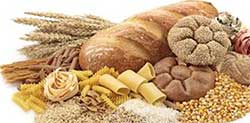We have all heard that carbohydrates are bad or cause weight gain. There are so many diets including no carb, low carb, and slow carb. Famous examples of these diets are the Adkin’s Diet and the South Beach Diet. But, who doesn’t LOVE foods we include in the carbohydrate catergory like dessert, bread, and pasta? So, what are carbs and how much should I eat?
The Science of a Carbohydrate
So this part can be overwhelming to anyone. I have trouble with it sometimes and I have a BS in Chemistry! So…bear with me for a bit. A carbohydrate, simply put, is a molecule consisting of carbon, hydrogen, and oxygen. A synonym for carbohydrate is a saccharide. Saccharides are further divided into groups based on the molecular weight. Those with the smallest molecular weight are referred to as sugars and commonly have a suffix of -ose. For example cane sugar is the disaccharide sucrose and milk sugar is the disaccharide lactose. Monosaccharides, such as glucose, are responsible for fuel for metabolism. Polysaccharides (saccharides with a high molecular weight), such as starch and glycogen, are responsible for storing energy.
Types of Carbohydrates
So enough of the chemistry :-). There are 3 main types of carbohydrates: sugar, fiber, and starch.
- Sugar: simplest form of carbohydrates. Examples are sucrose, lactose, and fructose. You can further divide sugar into a) naturally occurring sugars found in fruit and milk and b) added sugars such as high fructose corn syrup.
- Starch: a complex carbohydrate (many sugar units bonded together). Foods high in starch include grains, dried beans, potatoes, and corn.
- Fiber: a complex carbohydrate. Found in fruits, vegetables, and grains. Fiber only comes from plant foods, so there is no fiber in meat products.
Sugars
During intense forms of activity sugars are the main source of energy. In digestion, all sugars are broken down into glucose and fructose (except lactose). Once broken down into simple sugars they travel through the blood stream to cells to make proteins, provide energy, or be stored for further usage. As a matter of fact, red blood cells and the brain can only use glucose for energy.
Starches
The only function of starch is to be converted into glucose for energy. Starch not used immediately is stored as glycogen in your liver and muscles. Glycogen is burned as energy when you don’t eat before you exercise. Grains are a source of starch and have 3 parts: The outer shell or bran, the middle layer or germ, and the soft inside or the endosperm. The bran contains most of the fiber and B vitamins and minerals. The germ contains essential fatty acids and vitamin E. The endosperm contains the starch. Refined grain food contains only the endosperm . To reap the benefits of the whole grain you should eat “whole grain” foods.
Fiber
Fiber is the indigestible portion of plant food. Fiber moves along the digestive tract binding to cholesterol, carbohydrates, and water. By binding to cholesterol it decreases the overall blood cholesterol. It slows the absorption of other carbohydrates when binding to them, therefore reducing spikes in blood sugar. Fiber also bind to water and helps make bowel movements regular. Fiber is therefore is important in digestive health and making you feel full after a meal. Evidence reported from the Mayo Clinic “suggests that whole grains and dietary fiber from whole foods help reduce your risk of cardiovascular diseases and may also protect against obesity and type 2 diabetes.”
Fiber is found in beans, legumes, fruits with edible skin and seeds, nuts, and whole grains. Recommended daily intake is 25 grams/day for women and 38 grams/day for men. Unfortunately, I found out the hard way how important fiber is to my diet. I was on a no-carb diet for over a year and so didn’t get the appropriate amount of fiber. This led to severe constipation that herniated my colon through my diaphragm causing left sided chest pain. What would any physician think when a healthy 30 year old female presents with left sided chest pain? …Heart Attack of course! So after L-O-T-S of tests and money to rule out my heart, we came to conclusion that I was full of it! Ha, pun intended… Seriously though, I was constipated from eliminating carbohydrates and therefore fiber.
How Many Carbohydrates Should I Eat?
The American Diabetes Association recommends that each meal consist of 45-60 grams of carbohydrates. The Dietary Guidelines for Americans “recommends that carbohydrates make up 45 to 65 percent of your total daily calories. So, if you get 2,000 calories a day, between 900 and 1,300 calories should be from carbohydrates. That translates to between 225 and 325 grams of carbohydrates a day.” Food labels will help you identify the total carbohydrate content. Keep in mind this includes starches, fiber, sugar alcohols, and naturally occurring sugars. The ADA website has a great reference list identifying how many carbohydrates are in foods that don’t have a label.
So What Now?
We know that carbohydrates are important to our health as they provide the body with glucose which is converted to energy to support bodily functions and physical activity. The amount of carbohydrate consumed seems less important than the type of carbohydrate. To include healthy carbohydrates in your diet follow these rules:
- Choose whole grains
- Limit added sugars
- Choose low fat dairy options
- Eat more beans and legumes
- Choose fiber rich fruit and vegetables




